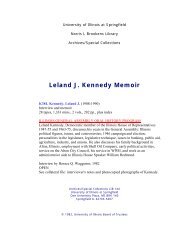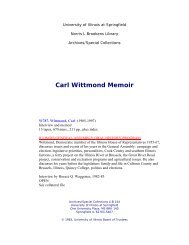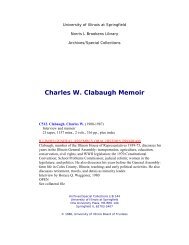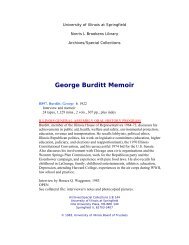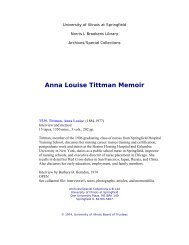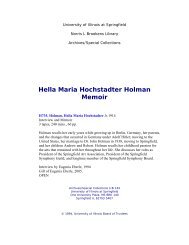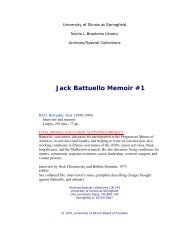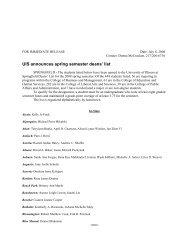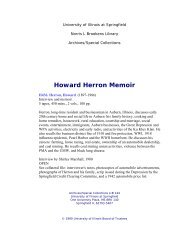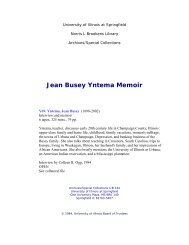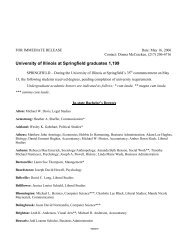Cecil A. Partee Memoir - University of Illinois Springfield
Cecil A. Partee Memoir - University of Illinois Springfield
Cecil A. Partee Memoir - University of Illinois Springfield
Create successful ePaper yourself
Turn your PDF publications into a flip-book with our unique Google optimized e-Paper software.
served or rehabilitated as well as in other areas <strong>of</strong> the state.<br />
would be my motivation.<br />
And,that<br />
Q: Was there anyone particular in your district that called this to<br />
attention, or called any particular buildings to your attention?<br />
A: No, I don't think so. They wouldn't have had to, I would have just recognized<br />
it on my own.<br />
Q: In 1971, with Senator Cherry, you made a mernorlal to the U. S. Congress<br />
to continue the model cities program. What was your concern with the model<br />
cities program, sir?<br />
A: Well, the Congress had given the impression that they were going to<br />
eliminate it and we felt that it should still obtain. You see, model<br />
cities came into existence when there was a lot <strong>of</strong> strife and unrest in the<br />
inner-cities across the nation. There were riots and other kinds <strong>of</strong> things<br />
and we felt that the model cities prpgram would be a very stabilizing<br />
influence on helping people to rehabilitate themselves and to get themselves<br />
started toward the regular job market. We wanted the Congress to know that<br />
it was our view that it would be disasterous if that program went down.<br />
Q: Was the program active in your district?<br />
1<br />
A: Oh, yes, very active in my district.<br />
Q: In what way? What was being done?<br />
A: Well, the model cities program, they hired a large number <strong>of</strong> people and<br />
the focus was on neighborhoods, and getting people within a particular<br />
neighborhood, through various kinds <strong>of</strong> federal.programs, to upgrade themselves,<br />
prepare themselves for additional kinds <strong>of</strong> responsibilities in the<br />
work market. And it also <strong>of</strong>fered employyent to people during the period <strong>of</strong><br />
transition between poverty and--moving forward. There were programs that<br />
actually fed people who were in necessitest circumstances. There were<br />
programs that were geared toward freeing women to work, like day care<br />
centers and things <strong>of</strong> that sort where their children could be kept in the<br />
daytime to free them to work. A11 <strong>of</strong> those programs, we felt, had a<br />
salutary effect on government in that, if you can get people <strong>of</strong>f <strong>of</strong> welfare<br />
rolls and <strong>of</strong>f <strong>of</strong> necessitest circumstances, where they are not earning, into<br />
giving them a viable kind <strong>of</strong> an existence, it would mean a great deal more<br />
to the state, to the people themselves and to the revenue impact on the<br />
state. It would be upgraded.<br />
Q: And did it continue?<br />
A: The model cities program continued until probably--it was just phased out<br />
in 1978, as a matter <strong>of</strong> fact. There were some other programs which came<br />
into existence which helped to support the same concept. At the federal<br />
level, many <strong>of</strong> the programs that were a part <strong>of</strong> the Democratic administration<br />
previously were eliminated but then the new concept <strong>of</strong> revenue sharing



